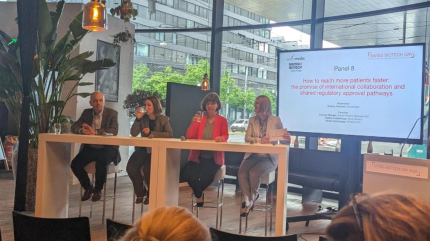
Global agencies have collaborated to create parallel regulatory approval solutions to help get drugs to patients more quickly. Experts who have used these schemes say that while these schemes have introduced unexpected challenges, they are heavily outweighed by the benefits.
At the Swiss Biotech Day 2025, which took place on 5-6 May in Basel, a panel of experts discussed three specific approval schemes: Project Orbis, the Access Consortium, and the Marketing Authorisation for Global Health Products (MAGHP), and how these can help accelerate drug approvals worldwide.

Discover B2B Marketing That Performs
Combine business intelligence and editorial excellence to reach engaged professionals across 36 leading media platforms.
Roche’s regulatory affairs head Corrine Wenger said that, as a Swiss company, such pathways that speed up approval in the home nation are attractive.
Speaking specifically on the Access Consortium, Wenger said: “We immediately felt this could be a great opportunity to streamline global resources to get faster access in Switzerland. We looked at the pipeline, identified a suitable candidate, proposed this pathway and persuaded the company to follow the procedure.”
The Access Consortium is a collaboration between agencies like Australia’s Therapeutic Goods Administration (TGA), Health Canada (HC), Singapore’s Health Sciences Authority (HSA), Swissmedic, and the UK’s Medicines and Healthcare products Regulatory Agency (MHRA).
The consortium has working groups focused on specific objectives that are designed to share information on manufacturing site assessments, technical guidelines, post-market surveillance, and more. This work is done under confidentiality agreements.

US Tariffs are shifting - will you react or anticipate?
Don’t let policy changes catch you off guard. Stay proactive with real-time data and expert analysis.
By GlobalData“We saved some global resources,” said Wenger on her experience with the consortium. In one case, the company got a fast approval in ten months instead of the standard 15 months in Switzerland, she said.
However, there were some challenges. For example, she commented that Roche did not originally estimate the resources that would be required to coordinate parallel submissions and communication with the agencies.
Discussing AstraZeneca’s experience with the Project Orbis pathway, Sabine Ledderhose, head of regulatory affairs for the company’s Swiss division, agreed that using a multi-country approval system is beneficial and hopes that the Orbis scheme specifically can be expanded beyond oncology to help expedite approvals for other therapies.
Project Orbis is an oncology-specific approval pathway, which was launched in May 2019 by the US Food and Drug Administration (FDA). The project allows companies to submit for market approval of a drug in several countries concurrently, including Australia, Brazil, Canada, Israel, Singapore, Switzerland and the UK.
Ledderhouse echoed Wenger’s sentiments about resource allocation.
“You can’t underestimate the resources you need. It’s sometimes difficult to predict when an information request will be received, but Swissmedic is great at alerting us, but that’s not the case for all agencies,” she said.
Since AstraZeneca views Switzerland as a “first-wave market”, the company is leveraging Orbis for type A submissions, which Ledderhouse says has been very beneficial for the company.
Sergio Cantoreggi, chief scientific officer of Swiss pharmaceutical company Sintetica, said that Visiclor Eye Gel was approved by both Swissmedic and the South African Health Products Regulatory Authority (SAHPRA) using the MAGHP procedure. This is one of only two companies that have so far opted to utilise this approval pathway. MAGHP is a Swissmedic-run initiative that cooperates with African countries. Despite it not being commonly used, Cantoreggi still described the experience as being very smooth and called on other conference attendees to consider using the procedure.
Note: Some travel expenses that allowed the Pharmaceutical Technology reporter to attend the Swiss Biotech Day conference were covered by the investment agency Switzerland Global Enterprise.





